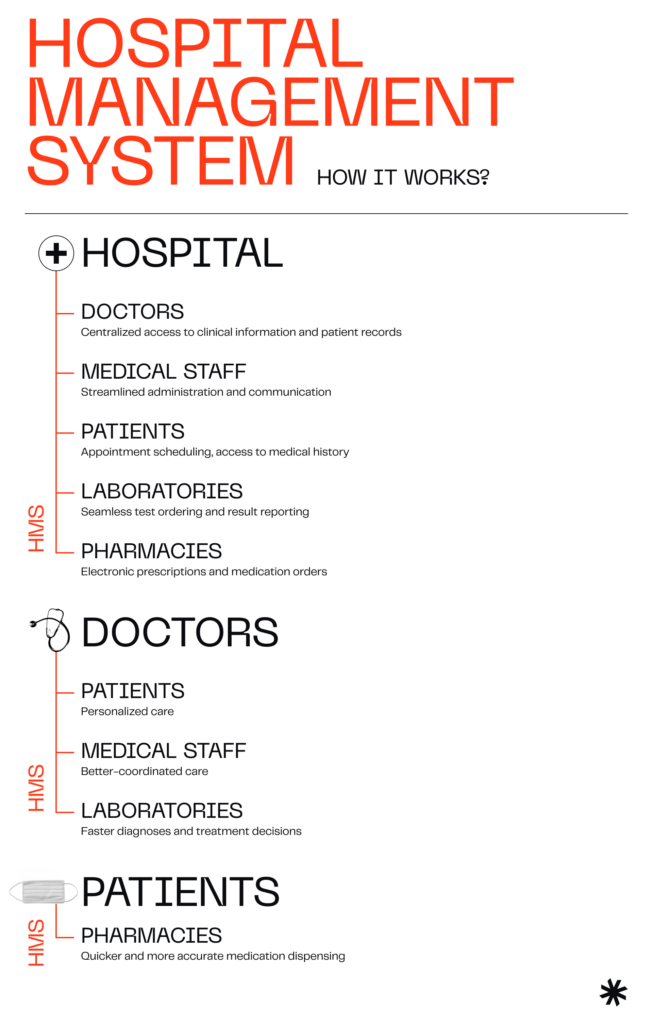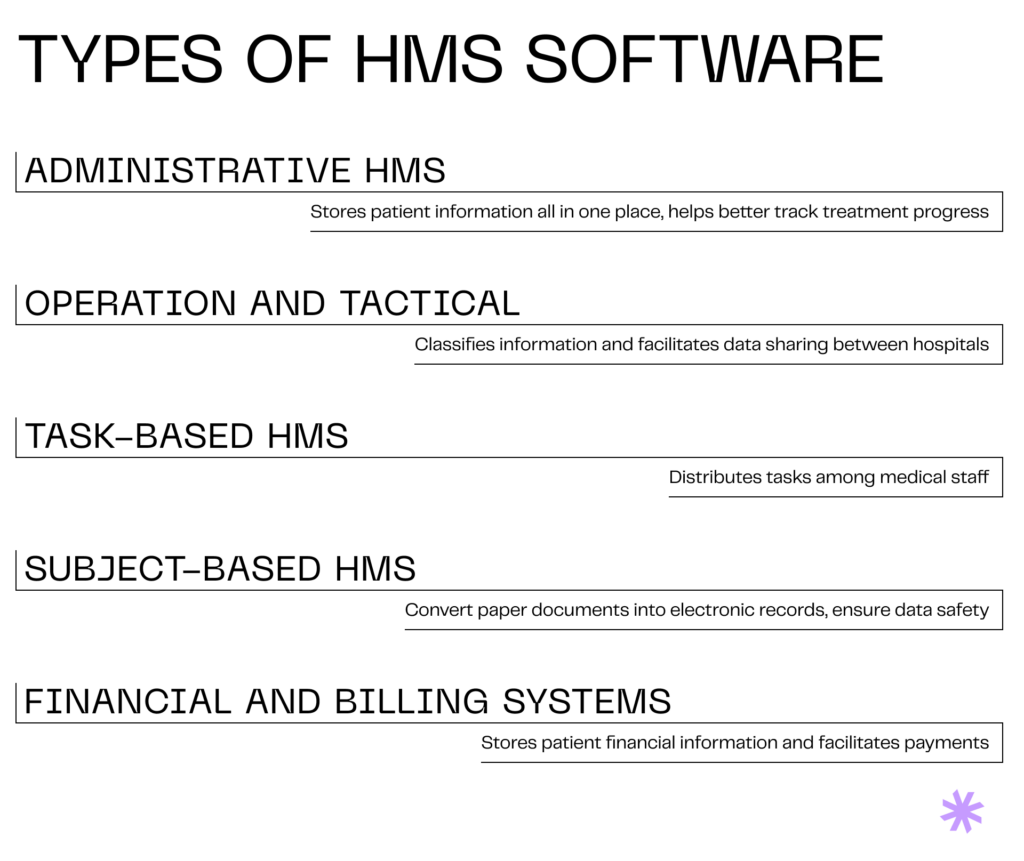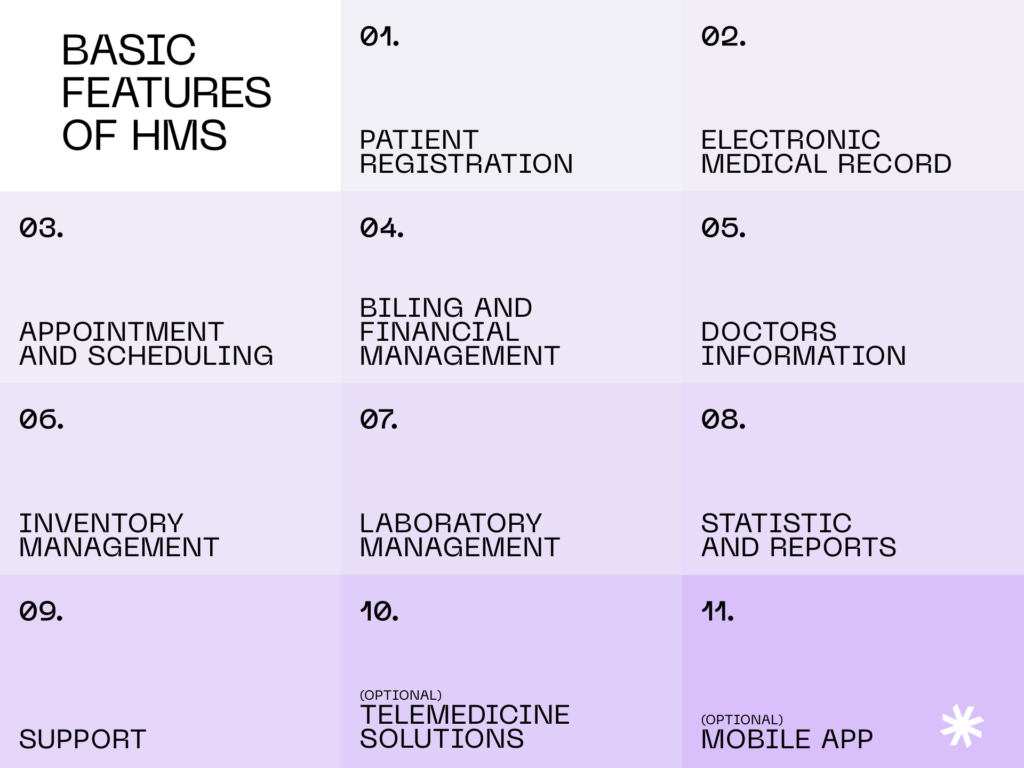Hospitals are increasingly adopting IT solutions to reduce costs while upholding service quality. According to research, the global hospital management software market is projected to experience a CAGR of 19.8% from 2022 to 2027.
Given that, the question of how to develop a hospital management system has become a pressing issue.
Luckily, Syndicode has an answer to this matter. We are a software development partner motivated by the desire to assist and guide medical software projects, ultimately increasing their chances of success in the market. Our team of engineers, designers, architects, and IT managers can help you with:
- Custom software development
- Project facilitation and assurance
- Staff solutions
- AI/ML innovations, and more.
Here’s our framework for building a hospital management system:
- Step 1. Conduct market research
- Step 2. Consider the challenges
- Step 3. Choose the right type of HMS
- Step 4. Select the must-have features
- Step 5. Consider the design
- Step 6. Define the right development approach
- Step 7. Launch an MVP first
- Step 8. Release a fully-fledged product
What is a hospital management information system?
Hospital management software can be defined as a digital system that helps manage all patient information and automates billing, scheduling, regulatory compliance, and appointment processes.
To understand a typical HMS workflow, let’s see the key participants:
- Patients use the software’s patient portal or related features to schedule appointments, view their health records, medical history, and billing information, and request prescription refills.
- Healthcare providers manage patient care, document clinical information, prescribe medications, and access patient data.
- Hospital administrators oversee the overall operation of the hospital and use the HMS for strategic planning, resource allocation, and financial management.
- Healthcare partners, such as finance teams and insurance companies, use the HMS for billing, claims processing, revenue cycle management, financial reporting, and patient coverage and benefits verification.
- Regulatory bodies can rely on the data and reports generated by the HMS to monitor and ensure that the hospital complies with healthcare regulations and standards.
The interaction between all those parties can be illustrated in the following way:

The key benefits of hospital management software
Using HMS software for hospitals offers several key benefits to all user groups. These benefits contribute to improved patient care, streamlined operations, and enhanced overall efficiency.
Thus, some of the primary advantages of healthcare management software for doctors include:
- Efficient patient management: Doctors can access patient records, medical histories, and treatment plans quickly, making it easier to provide comprehensive care.
- Time savings: Automation of administrative tasks like appointment scheduling and billing reduces paperwork and allows doctors to spend more time with patients.
- Improved communication among healthcare providers, enabling collaborative decision-making and care coordination.
- Clinical decision support tools embedded in the hospital information system provide doctors with evidence-based guidelines and alerts to assist in diagnosis and treatment decisions.
- Medication management and electronic prescribing reduce the risk of errors, improving patient safety.
- Quick access to test results: Doctors can receive and review test results promptly, leading to faster diagnoses and treatment decisions.
A hospital management software system offers significant benefits to patients, too:
- Convenient access to healthcare: Patients can schedule appointments, access medical records, and communicate with healthcare providers online, offering greater convenience and improving patient experience.
- Empowerment and involvement: Patients have more control over their health, as they can actively participate in their care, view test results, and make informed decisions.
- Reduced wait times thanks to online appointment scheduling and electronic communication.
Finally, hospitals decide to create hospital management software to improve the following:
- Efficiency and workflow optimization: Patient management software automates administrative tasks and improves resource allocation, leading to greater operational efficiency.
- Cost control: Improved billing, claims processing, and revenue cycle management enhance the hospital’s financial stability. In addition, efficient inventory management and pharmacy operations control costs by reducing waste and optimizing supply chain logistics.
- Reduced administrative expenses: Automating billing, coding, and claims management reduces administrative overhead.
- Compliance and data security: The HMS ensures that the hospital complies with healthcare regulations and data security standards, reducing legal risks.
- Data analytics: Hospitals can use data from the HMS to track performance metrics, patient outcomes, and resource utilization, supporting informed decision-making and quality improvement efforts.
You cannot afford lousy software when it comes to health
Tell us what you want to do, and we will ensure you get the best quality software and services.
Talk to salesHow to build a hospital management system
Developing hospital management software systems is essential in the modern healthcare landscape. The following steps outline why hospital management systems are crucial and how to build one effectively.
Step 1. Conduct market research
You might have a fantastic idea that could drastically improve hospital management programs. However, it’s essential to carefully examine the market to make sure your idea meets current user needs and can attract customers and generate income.
Thorough market research will help you find areas where there’s a lack of services and guide you in deciding what features to focus on. Here are the main steps to follow when conducting your market research:
- Identify the common challenges within healthcare facilities by studying industry reports and surveying. The challenges could include issues related to the management of information systems in hospitals, patient care, administrative tasks, billing, or communication.
- Understand user needs, including those of healthcare providers, administrators, and patients. By identifying pain points and areas where existing solutions fall short, you can set goals to address these gaps. Use industry reports, social media, and professional forums. Surveys and interviews are also a powerful instrument.
- Analyze competition in the hospital management system software market and identify their strengths and weaknesses. Note what software solutions have been developed to address user needs and brainstorm how you can create a hospital management system that will do it better.
Step 2. Consider development challenges
Developing hospital management software comes with specific challenges unique to the healthcare industry. These challenges should be considered during the planning stage:
- HIPAA compliance: The Health Insurance Portability and Accountability Act (HIPAA) regulates patient data protection and requires developers to implement complex data security and privacy measures.
Read also: How to make your software HIPAA compliant?
- Data integration: hospital software often needs to exchange data between a variety of systems, some of which may use legacy and proprietary technologies. Managing and standardizing this data is a complex task.
- Usability and user adoption: Healthcare professionals have busy schedules and limited time for training and onboarding. It’s crucial to make the medical software as intuitive as possible.
- Clinical decision support (CDS) tool incorporation is challenging due to the complexity of medical knowledge and the variability of clinical practices.
- Scalability: As healthcare facilities grow, the software must scale to accommodate increased data volume and user demand.
Overcoming these challenges requires careful planning, collaboration with stakeholders, and a deep understanding of healthcare processes. At Syndicode, we tackle these challenges using the following strategies:
- Microservices architecture helps us create software that can be easily expanded as needed.
- Data integration strategy: During the project’s discovery stage, we assess the types of data to be exchanged between systems and their formats. We develop a strategy that includes data mapping and transformation tools to ensure data transfer regardless of its original format.
- User-centered design: We involve healthcare professionals in the design process to align the software with their workflow and needs. We also prioritize interactive tutorials and tooltips, contextual help, and shortcuts for common actions.
- Usability testing is an integral part of our HMS software development process. Our QA specialists check the system against industry usability standards and identify areas for improvement. At the client’s request, we can additionally present the prototype to a focus group of healthcare professionals for more in-depth feedback.
- Agile development practices help us continuously assess the software’s capacity to handle increased data volume and user demand. Thus, we can make improvements as the project progresses.
Step 3. Choose the right type of hospital management system
Before discussing how to develop a hospital management system, let’s find out what types of software for hospitals are available on the market.
Based on the functions an HMS performs, such digital solutions are divided into the following categories:
- Administrative systems store and process information about patient interactions with doctors, such as medical history, treatment course, and medications.
Read also: The guide to CRM development
- Operational and tactical systems are created to avoid any inconsistencies in medical data within the whole system. All information is classified, structured, and interoperable at all levels of the medical institution. Different departments can access different healthcare records based on their user statuses.
- Task-based systems allow healthcare organizations to assign tasks to appropriate staff members and control their execution. Hospital managers use the software to manage staff duties and supervise the hospital activity.
- Subject-based systems help healthcare providers reduce the amount of paperwork by converting patients’ paper documents into Electronic Health Records (EHR) or Electronic Medical Records (EMR).
- Financial and billing systems platforms process patients’ treatment records and send them to their insurance companies to speed up the billing process.

Step 4. Select the required functionality
While it might be tempting to add all the features at once, practical constraints often make it impossible. Investor commitments, the need to launch quickly to capture the market at the right time, budget constraints, and other factors can limit what you can do.
As a result, you need to prioritize the essential functionalities that serve the hospital management system’s core purpose, along with features that make it appealing compared to other products.
Now, let’s look at the fundamental features that define a digital product as a Hospital Management System:
- Patient registration. An HMS software for hospitals should allow doctors to register new patients and enter their relevant information.
- Electronic health records (EHR) can be seen as patients’ health charts. The vital data included are medical history, radiology images, treatment plans, allergies, laboratory and test results, and prescribed medication
- Appointment and scheduling functionality. The system should enable healthcare providers to schedule and manage appointments and notify patients via phone or email.
- Billing and financial modules allow hospital administration to review financial documentation and manage financial operations, including taxes, reviews, and patient bills.
- Doctor profiles. Patients should be able to review the list of doctors available in the medical institution, their schedules, experience, and achievements.
- Inventory management helps keep track of the flow of medical supplies and apparel such as masks, emergency blankets, thermometers, and first aid kits.
- Laboratory management. With this feature, both patients and doctors can be quickly notified about the results of lab tests. Additionally, this information can be retrieved by authorized specialists at any time.
- Statistics and reports provide administrators with valuable insights that help develop the medical institution and improve its service quality.
- Pharmacy management enables medical staff members to monitor the expiration date of the drugs in their inventory and plan their delivery.
- Statistics and reports provide administrators with valuable insights that help develop the medical institution and improve its service quality.
- Integration with insurance services allows recording and storing patients’ insurance details, namely policy number, the insurance company’s name, and key information about policies. This way, it is easier for patients to manage their policies and payments.

Step 5. Consider the design
A carefully planned UI and UX is crucial for the success of an HMS, more so than in other digital products. An HMS serves various user groups, each with their unique interests and needs.
Additionally, the levels of digital expertise and willingness to learn new software can vary widely among these user groups.
To assist you in catering to the diverse needs of your patient management software target audience, our UX/UI design team has put together some helpful tips.
- Understand how the healthcare industry operates
The healthcare industry is one of the most complex domains due to a multitude of regulations varying from one country to another. So, before you dive into developing an HMS, it’s essential to have a clear picture of how patients access care and how medical institutions deliver it. This understanding will help you create the right user flow and functionalities for your system.
- Make sure that the design aligns with the user’s environment
To develop a hospital management system that will bring you stable profit, you need to ensure that your design aligns with the user’s environment.
Do you create a solution for a large medical center or a small clinic? How long are the patients ready to wait for the doctor’s appointment? Do they need the flexibility to update appointment times on the go?
Think carefully about how these environments will impact the design requirements and how users will interact with patient management software.
- Reduce distractions
Redundant tabs, flashy designs, and cumbersome functionality can become a source of distraction for healthcare providers, leading to delayed responses. This, in turn, can have serious consequences for the patient’s health. Given that, we recommend choosing a minimalistic design for your hospital database management system.
Step 6. Define the development approach
There are two ways to go about developing a hospital management system. You can either hire a custom software development company to create a software solution for you from scratch or use ready-made SaaS development solutions.
The ultimate choice will depend on your specific goals, timeframes, and budget.
| Custom software development | Ready-made software | |
|---|---|---|
| Security and stability | Can prioritize security, stability, and quality | May lack some features for security and stability |
| Scalability | Scalability can be optimized according to your needs | May have limitations in scalability |
| Design customization | Complete design flexibility to match your brand | Limited or no design changes |
| Feature customization | Highly customizable, tailored to your exact needs | Limited customization, may have unnecessary features |
| Time | Longer development time | Quick launch within hours |
| Cost | Likely higher initial costs, potential for cost savings in the long term | Affordable, but initial low price may grow with user numbers |
Thus, if you are restricted in time and money, you may opt for ready-made software. These products are known for their affordability and can be up and running within a few hours. However, it’s essential to be aware that the initial low cost may increase as the number of platform users grows.
Out-of-the-box solutions may also come with unnecessary features or, conversely, lack some essential ones. In other words, off-the-shelf software doesn’t allow for much customization.
However, if you have a large-scope long-term project that will evolve and grow, partnering with an outsourced software development company is the best approach.
A dedicated development team can craft a web development strategy that enables you to swiftly launch a basic version of your product and begin generating revenue.
Additionally, they will ensure that the software is highly customizable and scalable, providing a robust foundation for adding new features and accommodating your business’s growth.
Furthermore, this team can offer ongoing technical support, ensuring the continued smooth operation of your product.
How to ensure the long-term security of your HMS?
Select reliable technologies. This is how we’ve delivered efficient, maintainable software for almost a decade.
Check our techStep 7. Launch an MVP first
MVP development for healthcare can be compared to clinical trials for new medicine. Both procedures aim to test the solution’s feasibility, effectiveness, and safety before it reaches the wide market.
However, building an MVP has several advantages before clinical trials:
- Fast-to-market: You can release a basic version of your HMS within six months after the project starts. Shorter timeframes can be explained by the very nature of a “minimum viable product,” which offers basic functionality to help users understand the product’s purpose.
- Cost-effectiveness: MVP development lets you assess the importance of the selected functionality for a hospital management system project. If some features prove unnecessary, you can omit them during the final development stage, saving money.
- Increased value: By analyzing user feedback, you can enhance your product with features they genuinely need. Consequently, you’ll have more than a solution that works well only on paper. You’ll get a valuable product that effectively addresses specific healthcare challenges and helps save patients’ lives.
Step 8. Release a fully-fledged product
As soon as an MVP version of your software for hospitals is released and the feasibility of your idea is proven, it is time to gather feedback from early adopters. They may be healthcare providers, patients, or both. Their comments, observations, and insights will help you improve your product to make it even more efficient and helpful.
We also recommend using specific predefined KPI metrics to measure the success of your software solution. The most important of them are:
- Churn rate
- Customer acquisition cost
- Customer lifetime value
- Average revenue per user
The results will show you how users see the product’s current and future value.
The main requirements for the hospital management system
To define how to develop a hospital management system that will be efficient for both medical institutions and patients, you should consider the following requirements for the HMS solution:
- The solution should be intuitive and easy to use so all hospital staff members can cope effortlessly without a long and tedious training period.
- The robust and informative user interface should not allow any misunderstanding or inconsistencies regarding data that healthcare workers enter into the system.
- Hospital administration should set individual role-based access to the solution for each staff member based on their level of authority and responsibilities to control the sensitive data.
- The hospital management program must be able to provide relevant specialists with updated and accurate information per their request in a fast and secure way.
- The software solution should be compliant with the HIPAA standard.
- The system should have a scalable architecture to extend the existing functionality and the number of doctors, patients, or medical facilities to enhance healthcare service delivery.
How much does it cost to build a hospital management system?
Here, we would like to specify the key factors defining the final HMS price. They are as follows:
- Project complexity. It can be measured by the number of features and integrations and their overall complexity. The more sophisticated functionality you want to implement, the higher the price.
- Integrations with third-party services. Be aware that the solution may turn out rather expensive if you want to integrate advanced technologies like blockchain or augmented reality.
- Technology stack, namely hospital management system databases, programming languages, frameworks, libraries, and cloud storage used for HMS development.
- Development team size and location.
Based on our experience, the HMS development cost varies between $70,000 and 180,000 depending on the factors we discussed above.
Conclusion
In recent years, healthcare software has become increasingly sought-after. So, if you decide to develop a hospital management system, you have chosen the right moment. We hope this extensive guide provided you with all the important information on that matter.
If you need a reliable company to help you with HMS development, feel free to contact us. Syndicode houses all the specialists you may need to get your hospital management software from scratch – from business analytics and UX/UI designers to quality assurance and DevOps engineers. They will eagerly enrich your project with their expertise and smart ideas.
Frequently asked questions
-
What is medical management software used for?
Clinic management software manages medical, financial, legal, and administrative processes. It also helps handle day-to-day hospital operations, be it appointment scheduling, billing, inventory or pharmacy management, and other administrative tasks. Finally, clinic management systems allow for storing and retrieving important patient information, including disease history, prescribed medicine, allergies, or laboratory results.
-
What software do most hospitals use?
There are several types of software apps hospitals use to provide better patient care. They include Electronic Health Records (EHR) that contain all crucial patient information, hospital database management systems, and medical research software designed to train medical staff members. We should also mention medical diagnosis software, medical imaging solutions, e-prescribing systems, medical billing software, and telemedicine solutions.
-
What are the problems of the hospital management systems?
There are several issues that are often associated with health management software. The first one is cybersecurity threats. In recent years, we have witnessed many cases of data breaches in the healthcare field. Another challenge is compliance with legal regulations. Finally, we should mention the potential data loss and privacy issues. Since patients provide a lot of sensitive information such as social security numbers, identification proofs, and personal contact details, hospital management systems should be accessed by authorized users only.
-
Why is management important in hospitals?
Hospital management is crucial because it ensures the timely delivery of high-quality healthcare services. Furthermore, with proper management, hospital administrators can track finances by planning funds flow and controlling expenses more efficiently. Another function of hospital management is to guarantee the privacy of interaction between patients and doctors.
-
What programming language is used in medical devices?
The choice of a programming language always depends on the type of HMS you want to build and its exact features. Among the most popular programming languages that are known for their versatility and reliability are Java, JavaScript, Ruby, PHP, Python, and C++.
